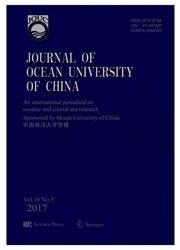

 中文摘要:
中文摘要:
This study examined the effects of salinity on embryonic development, survival, and growth of the Hong Kong oyster Crassostrea hongkongensis. The embryos, larvae, and juveniles of C. hongkongensis were held in artificial seawater at three different salinities(low, 15; medium, 23; and high, 30) to determine the optimum hatchery and nursery conditions for mass production of the seeds. Results showed that the percentage production of straight-hinged larvae from fertilized eggs was significantly lower at the high salinity than at the low- and medium-salinities(P < 0.05). The survival rates of larvae and juveniles differed significantly among the three salinity trials, with the highest survival rate observed at the low salinity(P < 0.05). The shell height of larvae was significantly larger at the low salinity than at the high and medium salinities from days 9 to 15(P < 0.05), whereas that of juveniles was significantly larger at the low salinity than at the high and medium salinities on day 70(P < 0.05). These results indicate that the larvae and juveniles of C. hongkongensis are tolerant to a wide range of salinities(15 to 30), but show better growth and survival at relatively low salinities. Thus, it is recommended to use relatively low salinities in hatchery and nursery systems for improved yields of C. hongkongensis.
 英文摘要:
英文摘要:
This study examined the effects of salinity on embryonic development,survival,and growth of the Hong Kong oyster Crassostrea hongkongensis.The embryos,larvae,and juveniles of C.hongkongensis were held in artificial seawater at three different salinities (low,15; medium,23; and high,30) to determine the optimum hatchery and nursery conditions for mass production of the seeds.Results showed that the percentage production of straight-hinged larvae from fertilized eggs was significantly lower at the high salinity than at the low-and medium-salinities (P < 0.05).The survival rates of larvae and juveniles differed significantly among the three salinity trials,with the highest survival rate observed at the low salinity (P< 0.05).The shell height of larvae was significantly larger at the low salinity than at the high and medium salinities from days 9 to 15 (P< 0.05),whereas that of juveniles was significantly larger at the low salinity than at the high and medium salinities on day 70 (P < 0.05).These results indicate that the larvae and juveniles of C.hongkongensis are tolerant to a wide range of salinities (15 to 30),but show better growth and survival at relatively low salinities.Thus,it is recommended to use relatively low salinities in hatchery and nursery systems for improved yields of C.hongkongensis.
 同期刊论文项目
同期刊论文项目
 同项目期刊论文
同项目期刊论文
 期刊信息
期刊信息
